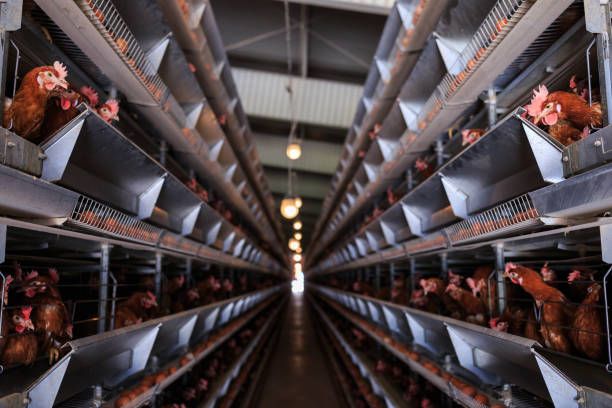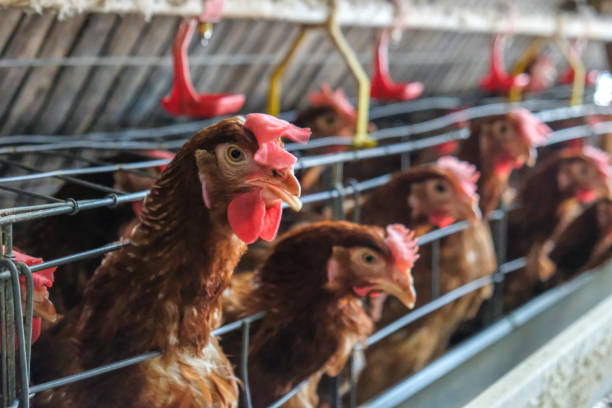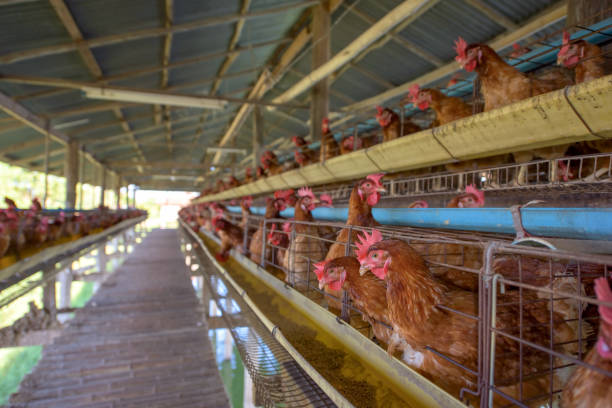
Chicken Cage Equipment Suppliers: A Guide to Quality and Affordability
Chicken Cage Equipment Suppliers: A Guide to Quality and Affordability
Finding the right chicken cage equipment supplier is crucial for the success of any poultry farming operation, whether you’re raising chickens for eggs or meat. Selecting the right supplier can significantly impact the health, productivity, and overall profitability of your farm. This guide explores what to look for in a supplier, the different types of chicken cage systems available, factors influencing affordability, and key considerations to ensure you get the best value for your investment.
**Why Choosing the Right Supplier Matters**
The quality of your chicken cage equipment directly affects your flock’s well-being. Poor quality cages can lead to injuries, stress, and disease outbreaks, ultimately impacting egg production or meat yield. A reliable supplier will offer durable, well-designed cages that promote a safe and comfortable environment for your chickens.
Moreover, a good supplier provides more than just equipment. They offer valuable support, including installation guidance, maintenance advice, and after-sales service. This support can be invaluable, especially for new farmers or those expanding their operations.
**Types of Chicken Cage Systems**
Chicken cage systems have evolved significantly over the years, each designed to meet specific needs and production goals. Here’s a breakdown of the most common types:
* **Layer Cages (Egg-Laying Chickens):** Layer cages, also known as battery cages, are designed to house hens specifically for egg production. These cages are typically arranged in rows and tiers, maximizing space utilization. Each cage usually houses multiple hens, providing them with access to feed, water, and a sloped floor that allows eggs to roll out for easy collection.
*Advantages of Layer Cages:*

* *High Density Housing:* Layer cages enable a large number of hens to be housed in a relatively small space.
* *Efficient Egg Collection:* The sloped floor design facilitates quick and easy egg collection, reducing labor costs.
* *Improved Hygiene:* The wire mesh floor allows droppings to fall through, reducing the risk of disease outbreaks.
* *Better Monitoring:* Individual or small groups of hens can be easily monitored for health and productivity.
*Disadvantages of Layer Cages:*
* *Animal Welfare Concerns:* Layer cages have been criticized for restricting the natural behaviors of hens, such as nesting, perching, and dust bathing.
* *Potential for Bone Weakness:* Limited movement can lead to bone weakness and osteoporosis in hens.
* **Broiler Cages (Meat Chickens):** Broiler cages are designed for raising chickens for meat production. These cages are typically larger and more spacious than layer cages, allowing broilers to move around more freely. They also feature easy access to feed and water, promoting rapid growth and weight gain.
*Advantages of Broiler Cages:*
* *Efficient Growth:* Controlled environment and easy access to resources promote rapid growth and weight gain.
* *Reduced Disease Risk:* The wire mesh floor helps keep broilers clean and dry, reducing the risk of disease outbreaks.
* *Improved Feed Conversion:* Broiler cages can help improve feed conversion rates, reducing feed costs.
* *Better Carcass Quality:* Reduced contact with droppings results in cleaner and higher quality carcasses.
*Disadvantages of Broiler Cages:*
* *Leg Problems:* Rapid growth rates can sometimes lead to leg problems in broilers, especially in intensive cage systems.
* *Animal Welfare Concerns:* Similar to layer cages, broiler cages can restrict natural behaviors and raise welfare concerns.
* **A-Frame Cages:** A-frame cages are a traditional design where the cages are arranged in an A-shape. This design allows for easy access to feed and water, and the sloped floor facilitates egg collection. A-frame cages are typically made from galvanized steel wire, providing durability and corrosion resistance.
*Advantages of A-Frame Cages:*
* *Simple Design:* A-frame cages are relatively simple to construct and maintain.
* *Easy Access:* The A-shape design allows for easy access to feed, water, and eggs.
* *Cost-Effective:* A-frame cages are often more affordable than other cage systems.
*Disadvantages of A-Frame Cages:*
* *Less Space Efficient:* A-frame cages may not utilize space as efficiently as other cage designs.
* *Manual Labor:* Egg collection and manure removal are typically done manually, increasing labor costs.
* **H-Frame Cages:** H-frame cages are a more modern design where the cages are arranged in a horizontal H-shape. This design allows for greater space utilization and can be easily automated for feeding, watering, and egg collection. H-frame cages are often used in large-scale commercial poultry farms.
*Advantages of H-Frame Cages:*
* *Space Efficiency:* H-frame cages maximize space utilization, allowing for a higher density of birds.
* *Automation:* H-frame cages can be easily automated for feeding, watering, and egg collection, reducing labor costs.
* *Improved Hygiene:* Automated manure removal systems can improve hygiene and reduce the risk of disease outbreaks.
*Disadvantages of H-Frame Cages:*
* *Higher Initial Cost:* H-frame cages typically have a higher initial cost than other cage systems.
* *Complexity:* The automated systems require regular maintenance and specialized knowledge.
* **Flat Deck Cages:** Flat deck cages are designed with a single layer of cages on a flat surface. This design is often used for smaller-scale poultry farms or for raising chicks. Flat deck cages provide easy access to the birds and allow for close monitoring of their health and development.
*Advantages of Flat Deck Cages:*
* *Easy Access:* Flat deck cages provide easy access to the birds for feeding, watering, and monitoring.
* *Simple Management:* The single-layer design simplifies management and reduces the risk of injury.
* *Suitable for Chicks:* Flat deck cages are well-suited for raising chicks and young birds.
*Disadvantages of Flat Deck Cages:*
* *Low Density:* Flat deck cages have a lower density compared to multi-tiered cage systems.
* *Higher Labor Costs:* Egg collection and manure removal are typically done manually, increasing labor costs.
**Factors Influencing Affordability**
The affordability of chicken cage equipment depends on several factors. Understanding these factors can help you make informed decisions and find the best value for your money:
* **Material Quality:** The type of material used to construct the cages significantly impacts their durability and lifespan. Galvanized steel is a popular choice due to its corrosion resistance and strength. However, higher-grade materials may come with a higher price tag.
* **Cage Design:** The complexity of the cage design also affects the cost. Simple designs like A-frame cages are generally more affordable than automated H-frame systems.
* **Automation Level:** Automated systems for feeding, watering, and egg collection can significantly reduce labor costs but come with a higher initial investment.
* **Supplier Location:** Suppliers located closer to your farm may offer lower transportation costs. Consider local suppliers or those with efficient distribution networks.
* **Order Volume:** Many suppliers offer discounts for bulk orders. If you’re planning a large-scale operation, ordering in bulk can help you save money.
* **After-Sales Service:** Consider the cost of after-sales service, including installation, maintenance, and spare parts. A supplier that offers comprehensive support can save you money in the long run by minimizing downtime and repair costs.
**Key Considerations When Choosing a Supplier**
Selecting the right chicken cage equipment supplier requires careful consideration. Here are some key factors to keep in mind:

* **Reputation and Experience:** Look for suppliers with a strong reputation and a proven track record in the industry. Check online reviews, ask for references, and visit their facilities if possible.
* **Product Quality:** Inspect the quality of the cages firsthand. Look for sturdy construction, smooth edges, and proper galvanization to prevent corrosion.
* **Customization Options:** Choose a supplier that offers customization options to meet your specific needs. This may include adjusting cage sizes, adding features, or integrating with existing equipment.
* **Compliance with Regulations:** Ensure that the supplier’s cages comply with all relevant animal welfare regulations and industry standards. This is particularly important if you plan to sell your products to retailers or consumers who prioritize ethical sourcing.
* **Warranty and Support:** Look for suppliers that offer a comprehensive warranty on their products and provide ongoing technical support. This can protect your investment and minimize the risk of costly repairs or replacements.
* **Pricing Transparency:** Choose a supplier that offers transparent pricing and clearly outlines all costs, including equipment, installation, and ongoing maintenance.
**Tips for Negotiating the Best Price**
Negotiating with chicken cage equipment suppliers can help you secure the best possible price. Here are some tips to keep in mind:
* **Do Your Research:** Before contacting suppliers, research the average market price for the type of cages you need. This will give you a baseline for negotiation.
* **Get Multiple Quotes:** Contact several suppliers and ask for detailed quotes. Compare the quotes carefully, paying attention to the quality of the materials, the features included, and the level of support offered.
* **Be Prepared to Walk Away:** Don’t be afraid to walk away from a deal if you’re not happy with the price or terms. Suppliers are often willing to negotiate to secure your business.
* **Ask for Discounts:** Inquire about discounts for bulk orders, seasonal promotions, or first-time customers.
* **Bundle Services:** Consider bundling equipment with installation or maintenance services to negotiate a better overall price.
* **Pay in Cash:** If possible, offer to pay in cash in exchange for a discount. Many suppliers are willing to offer a lower price for cash payments.
**Maintaining Your Chicken Cage Equipment**
Proper maintenance is essential for extending the lifespan of your chicken cage equipment and maximizing its efficiency. Here are some tips for maintaining your cages:
* **Regular Cleaning:** Clean the cages regularly to remove droppings, feathers, and other debris. This will help prevent the spread of disease and improve the overall hygiene of your farm.
* **Inspect for Damage:** Regularly inspect the cages for signs of damage, such as broken wires, loose connections, or corrosion. Repair or replace damaged components promptly to prevent further deterioration.

* **Lubricate Moving Parts:** Lubricate moving parts, such as hinges and latches, to ensure smooth operation and prevent wear and tear.
* **Maintain Automated Systems:** Regularly maintain automated systems, such as feeding, watering, and egg collection, to ensure they are functioning properly. Follow the manufacturer’s instructions for maintenance and repair.
* **Pest Control:** Implement a pest control program to prevent rodents, insects, and other pests from damaging the cages or contaminating the feed.
**The Future of Chicken Cage Equipment**
The chicken cage industry is constantly evolving, with new technologies and designs emerging to improve efficiency, animal welfare, and sustainability. Some of the trends shaping the future of chicken cage equipment include:
* **Enhanced Animal Welfare:** There is a growing demand for cage systems that prioritize animal welfare, allowing chickens to engage in natural behaviors such as nesting, perching, and dust bathing.
* **Smart Farming Technologies:** The integration of sensors, data analytics, and automation is enabling farmers to monitor and manage their flocks more efficiently, optimizing feed consumption, egg production, and overall health.
* **Sustainable Materials:** There is a growing interest in using sustainable and eco-friendly materials in the construction of chicken cages, reducing the environmental impact of poultry farming.
* **Precision Feeding:** Precision feeding systems that deliver customized rations to individual birds based on their specific needs are becoming more common, improving feed conversion and reducing waste.
* **Modular and Scalable Designs:** Modular and scalable cage designs that can be easily adapted to different farm sizes and production goals are gaining popularity.
By staying informed about these trends and working with reputable suppliers, you can ensure that your chicken cage equipment is up-to-date, efficient, and aligned with the highest standards of animal welfare and sustainability. Choosing the right supplier is a critical step in building a successful and profitable poultry farming operation.
